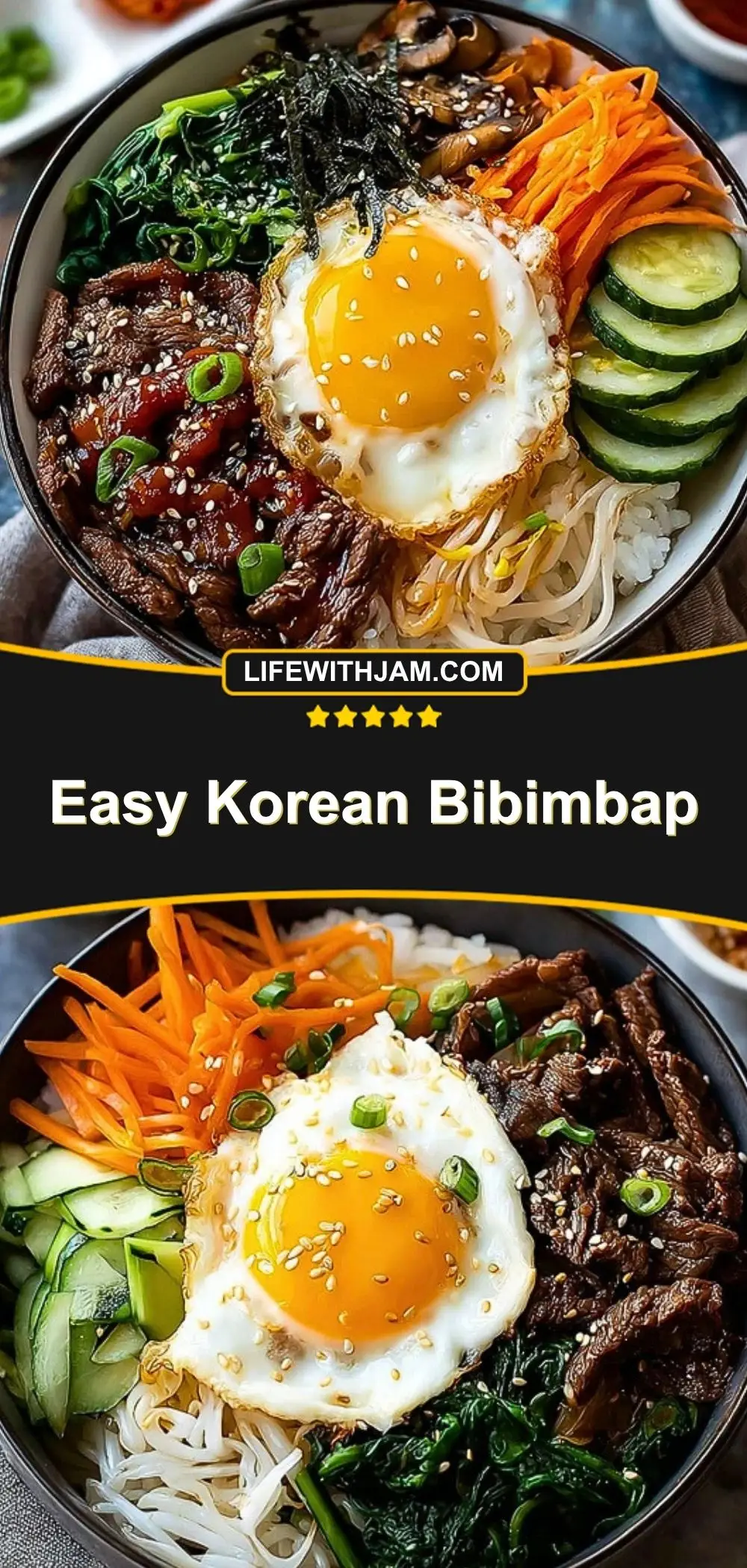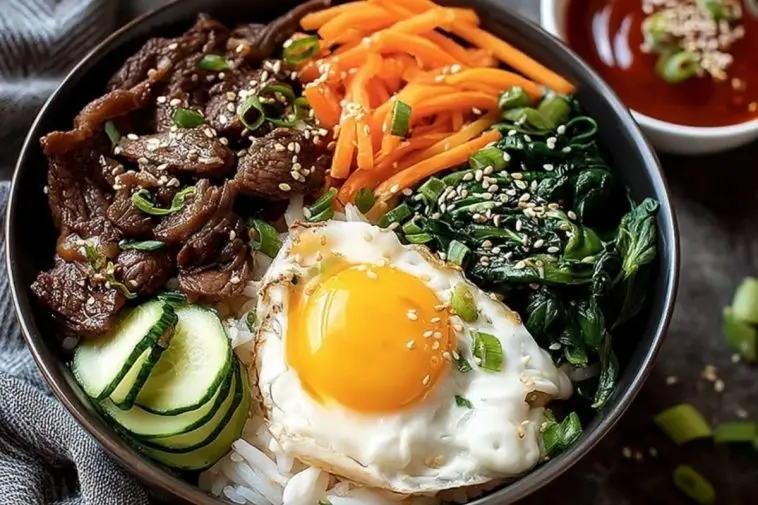Bibimbap is a vibrant, flavor-packed Korean rice bowl that’s as beautiful to look at as it is to eat. Traditionally served with a variety of sautéed vegetables, marinated beef, and a fried egg on top, this dish offers a delightful mix of textures and tastes with every bite. It’s hearty, nourishing, and endlessly customizable for whatever ingredients you have on hand.
This Easy Korean Bibimbap recipe brings the traditional Korean favorite into your home kitchen with a simplified approach. Whether you’re craving something wholesome for dinner or want to impress guests with a colorful, Instagram-worthy dish, bibimbap is a satisfying option that’s easier to make than it looks.
What Kind of Rice Should I Use for Bibimbap?
Short-grain white rice is most commonly used for bibimbap because of its sticky texture, which helps hold everything together in the bowl. If you prefer a healthier twist, brown rice or even cauliflower rice can also work well. The key is using rice that can support all the toppings without falling apart.

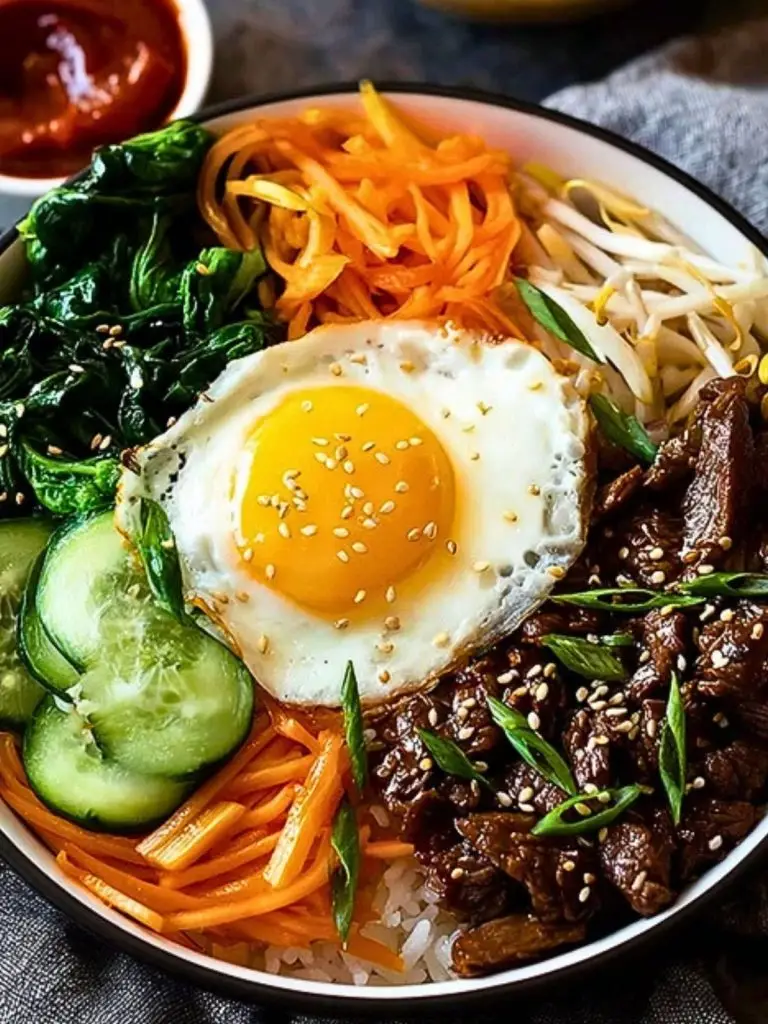
Ingredients for the Easy Korean Bibimbap
Cooked White Rice – Acts as the base of the dish, soaking up the flavors from the toppings and sauce.
Marinated Beef (Bulgogi) – Adds rich, savory umami and protein. Thinly sliced ribeye or sirloin is ideal.
Carrots – Julienned and lightly sautéed for a sweet crunch and vibrant color.
Spinach – Quickly blanched and seasoned for a soft, earthy green element.
Bean Sprouts – Adds freshness and a crisp texture.
Cucumber – Thinly sliced for coolness and balance.
Fried Egg – The iconic sunny-side-up egg brings richness and visual appeal.
Gochujang Sauce – Spicy and slightly sweet, this fermented chili paste ties the whole dish together.
Sesame Oil and Seeds – For nutty aroma and finishing texture.
Green Onions – For brightness and crunch in every bite.
How To Make the Easy Korean Bibimbap
Step 1: Cook the Rice
Prepare your short-grain white rice according to package instructions. Make sure it’s slightly sticky so it holds well at the bottom of the bowl.
Step 2: Sauté the Vegetables
In a skillet with a little sesame oil, sauté julienned carrots until tender-crisp. Blanch the spinach in boiling water for 30 seconds, drain well, and season with a pinch of salt and sesame oil. Lightly cook bean sprouts the same way. Keep all vegetables separate for serving.
Step 3: Prepare the Marinated Beef
Marinate thinly sliced beef in a mixture of soy sauce, garlic, sugar, sesame oil, and a splash of rice vinegar. Cook on medium-high heat until caramelized and fully cooked.
Step 4: Fry the Egg
Fry an egg sunny-side up. The runny yolk adds rich flavor when mixed into the bowl.
Step 5: Assemble the Bibimbap Bowl
In each serving bowl, scoop a portion of rice. Neatly arrange vegetables and beef in sections on top. Add the fried egg at the center.
Step 6: Drizzle and Garnish
Drizzle with gochujang sauce, sprinkle sesame seeds, and top with sliced green onions. Mix everything together before eating.
How to Serve and Store Easy Korean Bibimbap
Bibimbap is best served fresh and hot right after assembly, when the egg yolk is still warm and the beef is juicy. Present it in shallow bowls so you can see all the beautiful toppings before mixing. For an authentic twist, serve in a hot stone bowl (dolsot) to crisp up the rice bottom.
Leftovers can be stored in separate containers in the fridge for up to 3 days. To reheat, warm the rice and toppings separately in the microwave or a skillet, then top with a freshly fried egg and sauce just before serving.
Frequently Asked Questions
What does “bibimbap” mean?
Bibimbap literally translates to “mixed rice” in Korean. It refers to the act of mixing all the ingredients together before eating.
Can I make this vegetarian?
Absolutely! Swap out the beef for sautéed mushrooms or tofu. You can also bulk it up with more vegetables like zucchini or bell peppers.
Is gochujang very spicy?
Gochujang has a spicy kick, but it’s balanced with sweetness and depth. Start with a small amount and add more as needed.
Can I meal prep bibimbap?
Yes! Prepare the vegetables, beef, and rice ahead of time and store them separately. Assemble bowls when ready to eat and top with a freshly cooked egg.
What if I don’t have sesame oil?
While sesame oil adds a signature nutty aroma, you can use a neutral oil like avocado or olive oil in a pinch. Just add toasted sesame seeds for that flavor.
Can I use a different protein?
Definitely. Chicken, shrimp, tofu, or even tempeh all work well depending on your preference.
Want More Bowl Meal Ideas?
If you love building meals in a bowl like this Korean bibimbap, here are more cozy and flavorful options you’ll enjoy:
- Try the rich and brothy Easy Thai Red Curry Dumpling Soup for another Asian-inspired comfort bowl.
- This Grilled Chicken Broccoli Bowl with Creamy Garlic Sauce is a hearty protein-packed favorite.
- Savor the bold flavors of Dirty Rice with Ground Beef—perfect for weeknight comfort.
- Craving pasta? Creamy Cheesy Garlic Butter Rigatoni with Savory Beef hits the spot.
- Or go for cozy with One Pot Creamy Beef and Garlic Butter Pasta.
For more creative and delicious bowl ideas, follow me on Pinterest: Life with Jam Recipes
Save This Pin + Share Your Results
📌 Save this recipe to your Pinterest dinner board so you can come back to it any time.
And let me know in the comments how yours turned out. Did you try tofu or keep the beef? Did you go extra spicy with the gochujang?
I love hearing how you put your own twist on these meals. Ask questions or share your tweaks—let’s inspire each other in the kitchen!
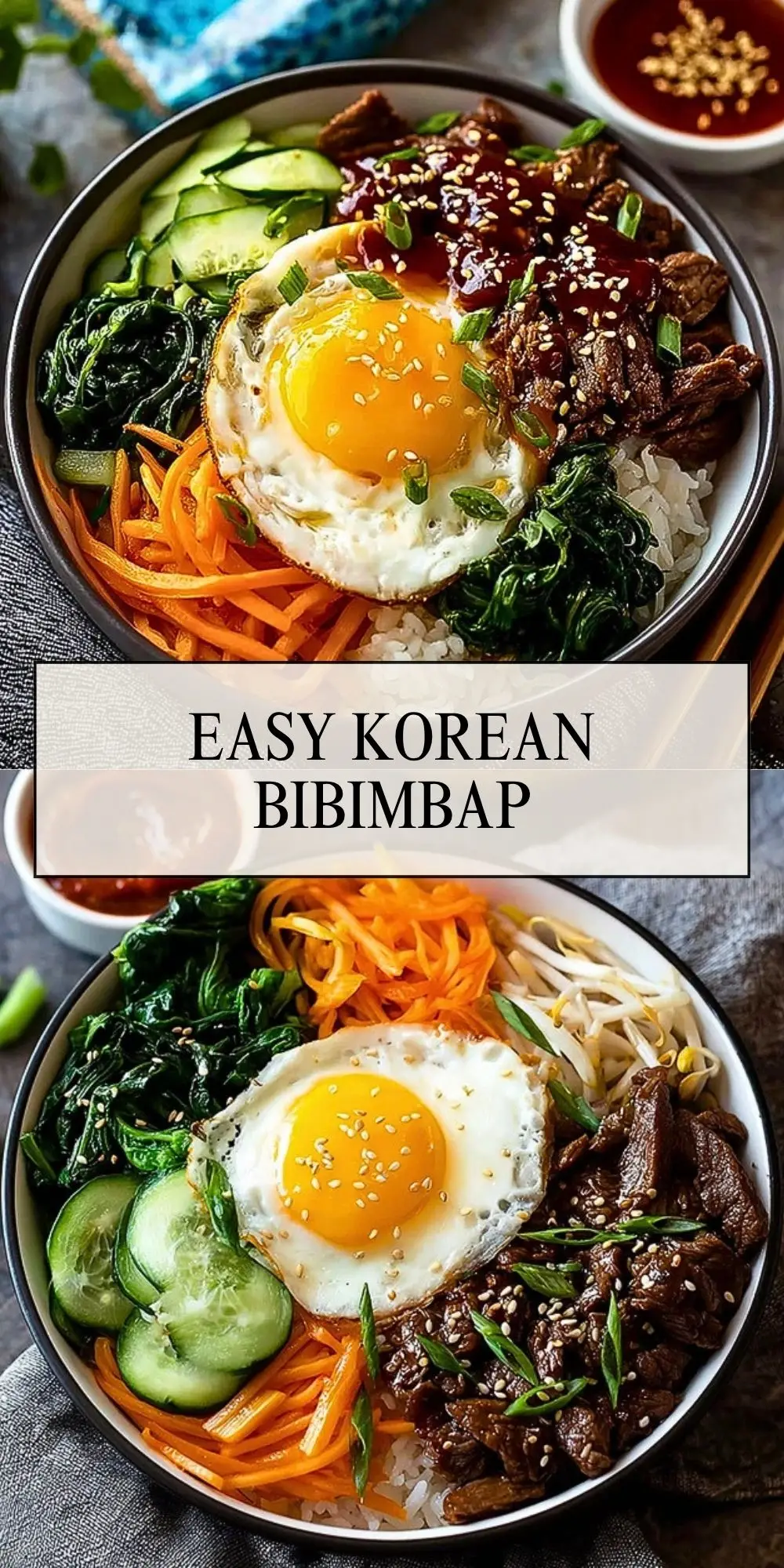
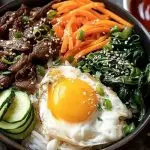
Easy Korean Bibimbap
- Total Time: 30 minutes
- Yield: 2 servings
Description
A colorful and satisfying Korean rice bowl, bibimbap brings together sautéed vegetables, marinated beef, a fried egg, and gochujang sauce over warm rice. It’s nutritious, customizable, and packed with flavor in every bite.
Ingredients
1 cup cooked white rice
4 oz marinated beef (bulgogi-style, thinly sliced ribeye or sirloin)
1 medium carrot, julienned
1 cup spinach, blanched
1/2 cup bean sprouts
1/4 cup cucumber, thinly sliced
1 large egg
1 tablespoon gochujang
1 teaspoon sesame oil
1 teaspoon sesame seeds
1 tablespoon sliced green onions
Instructions
1. Cook the rice according to package directions until slightly sticky. Set aside.
2. In a pan with sesame oil, sauté carrots until tender-crisp. Blanch spinach and season lightly. Cook bean sprouts briefly.
3. Marinate beef in soy sauce, garlic, sugar, sesame oil, and vinegar. Cook in a skillet until browned and caramelized.
4. Fry an egg sunny-side up.
5. In a bowl, add a portion of cooked rice. Arrange vegetables and beef in sections.
6. Top with the fried egg.
7. Drizzle with gochujang sauce, sprinkle sesame seeds, and green onions. Mix before eating.
Notes
Use freshly cooked rice or reheat day-old rice with a splash of water to restore softness.
For a crispy base, serve in a preheated stone bowl and let the rice sizzle before mixing.
Make it vegetarian by substituting tofu for beef and doubling up on veggies like mushrooms and zucchini.
- Prep Time: 15 minutes
- Cook Time: 15 minutes
- Category: Main Dish
- Method: Stir-fry & Assemble
- Cuisine: Korean
Nutrition
- Serving Size: 1 bowl
- Calories: 430
- Sugar: 5g
- Sodium: 520mg
- Fat: 17g
- Saturated Fat: 5g
- Unsaturated Fat: 10g
- Trans Fat: 0g
- Carbohydrates: 44g
- Fiber: 3g
- Protein: 23g
- Cholesterol: 145mg
